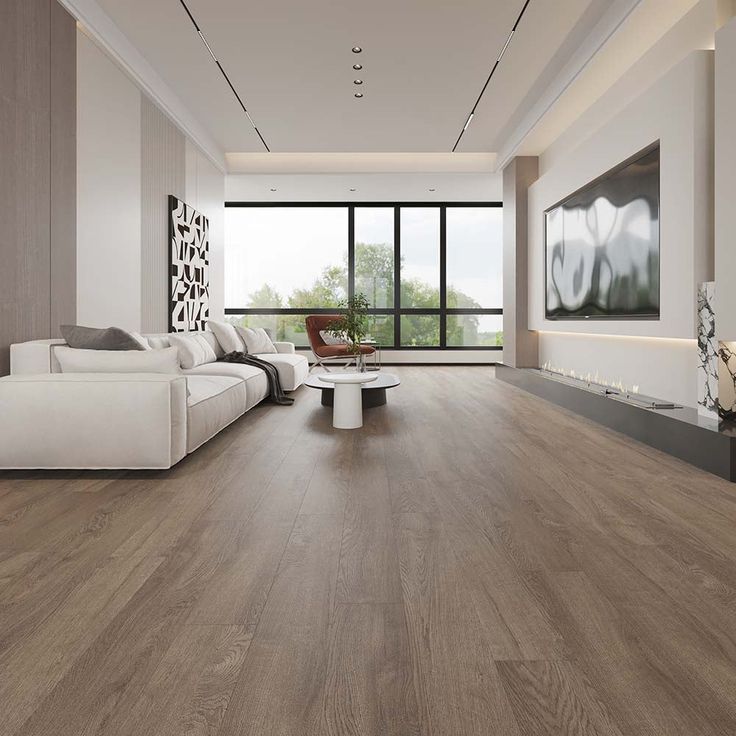As we step into 2025, wood flooring continues to be a cornerstone of interior design, celebrated for its natural beauty, durability, and ability to add warmth and character to any space. The trends for the coming year reflect a growing desire for authenticity, sustainability, and sophisticated aesthetics that blend seamlessly with modern living. Homeowners are increasingly looking for wood flooring options that not only look stunning but also align with eco-conscious values and offer enhanced performance.
This article explores the top wood flooring trends set to define homes in 2025, showcasing how innovation and timeless appeal are shaping the industry.
1. Wide and Extra-Long Planks: The Grand Scale
The preference for larger format flooring remains a dominant trend. Wide and extra-long planks create a sense of expansiveness and luxury, making rooms feel larger and more cohesive.
- Visual Impact: Fewer seams mean a more continuous and flowing look, which is particularly effective in open-plan living spaces. This style offers a grander, more sophisticated aesthetic that minimizes visual clutter.
- Species Popularity: This trend is prevalent across various wood species, with oak, walnut, and even some lighter-toned woods being popular choices for these larger dimensions.
2. Natural and Ultra-Matte Finishes: Embracing Authenticity
The shift away from high-gloss, reflective surfaces continues, with natural and ultra-matte finishes taking center stage.
- Authentic Look and Feel: These low-sheen finishes allow the inherent beauty and texture of the wood to shine through, creating a raw, organic, and understated elegance. They mimic the look of untreated wood, offering a more genuine connection to nature.
- Practicality: Matte finishes are highly practical as they are much more forgiving when it comes to showing dust, minor scratches, and everyday wear and tear, requiring less meticulous cleaning than their glossy counterparts.
- Popularity: Natural oil and hardwax oil finishes are particularly favored for their ability to penetrate and protect the wood from within, offering easy spot repair and a truly authentic feel.
3. Light and Warm Wood Tones: Brightening Spaces
While darker woods will always have their place, lighter and warmer wood tones are gaining significant traction, aligning with a desire for brighter, airier interiors.
- Scandinavian and Japandi Influence: Light oaks, whitewashed pines, and natural ash tones are highly popular, reflecting the minimalist and serene aesthetics of Scandinavian and Japandi design. These shades help to maximize natural light and make spaces feel more open.
- Inviting Atmosphere: Warm, honey-toned woods create a cozy and inviting ambiance, perfect for living rooms and bedrooms.
- Versatility: These neutral and warm tones provide a versatile backdrop that complements a wide range of interior design styles and color palettes.
4. Herringbone and Chevron Patterns: Geometric Sophistication
Classic geometric patterns are making a strong comeback, adding a layer of sophistication and visual interest to wood floors.
- Timeless Elegance: Herringbone (planks laid in a zigzag pattern) and chevron (planks cut at an angle to form a continuous point) designs bring a touch of traditional luxury with a modern twist.
- Defining Zones: These patterns are excellent for defining specific areas within an open-plan space or adding a dramatic focal point in entryways and dining rooms.
- Engineered Wood Suitability: These intricate patterns are often achieved more easily and stably with engineered wood blocks, which are less prone to movement than solid wood in these configurations.
5. Sustainable Sourcing and Eco-Conscious Choices
Environmental responsibility is a growing priority for homeowners, influencing wood flooring choices.
- Certified Wood: Demand for FSC (Forest Stewardship Council) and PEFC (Programme for the Endorsement of Forest Certification) certified wood is increasing, ensuring timber comes from responsibly managed forests.
- Engineered Wood Preference: Engineered wood is often seen as a more sustainable choice due to its efficient use of precious hardwood veneers over faster-growing core materials.
- Reclaimed and Recycled Wood: Giving salvaged timber a second life is the ultimate eco-friendly option, offering unique character and reducing demand for new logging.
- Low-VOC Finishes: Homeowners are opting for finishes and adhesives with low or zero volatile organic compound (VOC) emissions to ensure healthier indoor air quality.
Conclusion
Wood flooring in 2025 is characterized by a harmonious blend of classic elegance and contemporary innovation. The trends highlight a preference for grander scales, natural aesthetics, and a strong commitment to sustainability. By choosing wide planks, embracing matte finishes, opting for light and warm tones, exploring geometric patterns, and prioritizing eco-friendly sourcing, homeowners can create stunning, durable, and responsible wood floors that will remain a cherished feature of their homes for generations.

